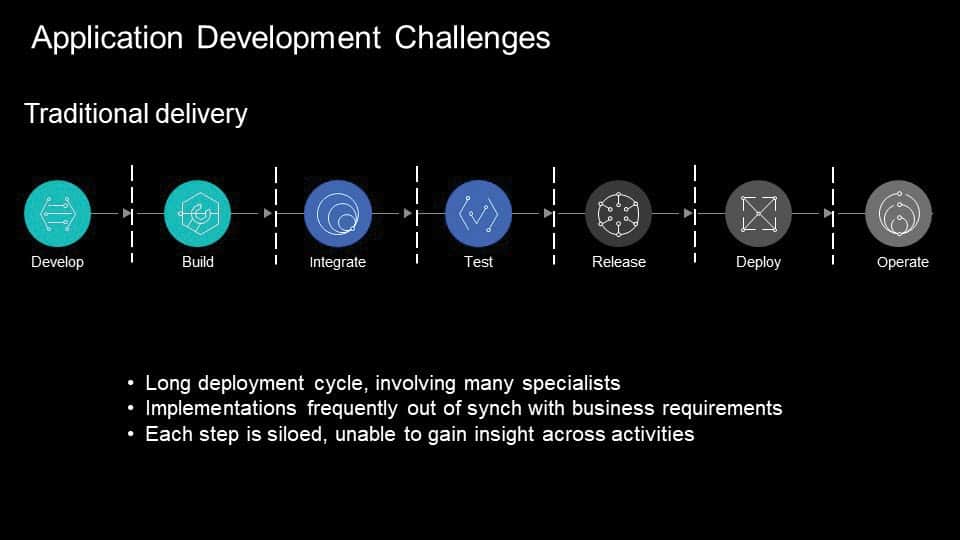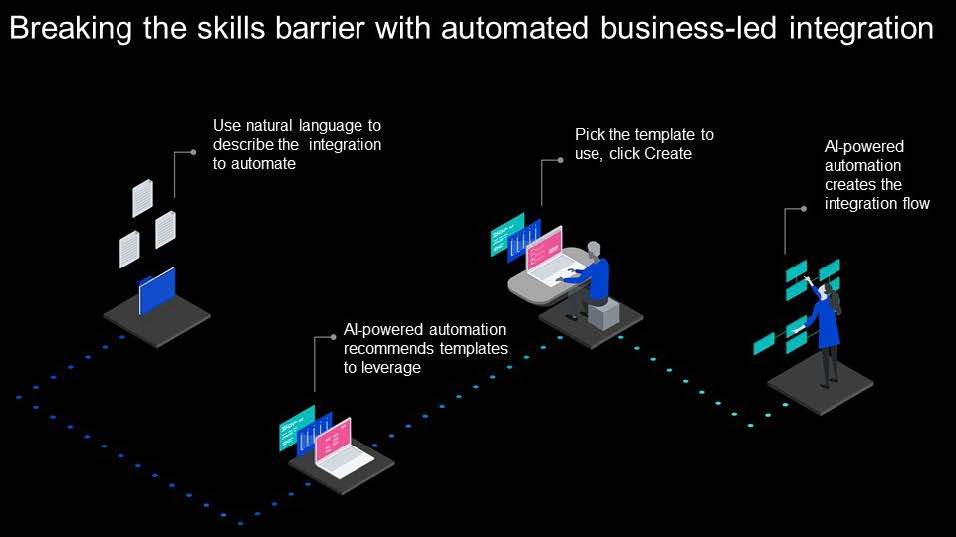Sponsored by IBM

Enabling Business-Led Integration with Automation
Chapter 1: Why Lines of Business Must Drive Integration
Modern business moves at a fast pace. Because of that, lines of business (LoB) are often frustrated when it takes weeks, months, or even longer for their ideas to become a reality. What is worse is that, once a project is started, LoBs are often left out of the process. That can lead to a mismatch between what the LoBs had envisioned and what is actually delivered.
![Webinar: Power your digital transformation efforts with IBM API Connect on AWS [Register Now]](https://no-cache.hubspot.com/cta/default/8019034/50b21c6a-2dde-4aad-a925-47a5a4339c14.png)
The bottom line is that LoBs must lead their projects and the integrations that are needed to pull everything together. Adoption of technologies like low-code development and reusable, composable components offer some relief. They allow LoBs to quickly automate simple processes and develop their own applications. However, those approaches fall short when there is a need to integrate with existing backend systems.
Such integration is typically a complex endeavor. Due to their value to the company, access to backend systems is tightly controlled and limited, and integration typically requires multiple people with different skills to be involved. That brings us back to square one. LoBs must wait for resources to become available to tackle their projects.

Integration challenges
Why is integration so critical? Traditional approaches to integration are so complex that they often do not meet the objectives of the lines of business. The manual steps and the reliance on individually skilled users working sequentially on unique integrations for each requirement mean the process is rigid and resistant to improvement. If requirements change, or an LoB sees that an initial effort is not producing the desired results, there is little opportunity to make changes or address issues.
As a result, the stakeholders in the lines of business often end up frustrated because of the long timeframes involved and the lack of input they can provide. In many cases, they may miss a business opportunity because the integrations could not be provided fast enough, or they could not adapt quickly to meet changing market conditions.
Enter automated integration
A typical integration is a multi-step process where each step requires different technical expertise. The process starts when an LoB scopes out a new application, service, or feature in an existing offering. For example, an online retailer might want to enhance a customer’s site visit by providing real-time recommendations based on past purchases. That would require extraction of the customer’s order history from a CRM system, real-time correlation of that data with the items viewed in the current visit, and then a presentation of comparable or sponsored items in an inventory management system.
It is obvious that there are several distinct integrations required to enable recommendations based on past purchases. There must be a connection between the web session and the CRM, the past order data and the recommendation engine, the recommendation engine results and the inventory management system, and then the inventory management system and the web session. Carrying out all those integrations in traditional ways might require developers, database specialists, data analysts, CRM administrators, and more.
Increasingly, an alternative approach that seeks to automate integration is being considered. Such an approach would let the LoBs have a more active role in the integration process, ensuring that the results are focused on their requirements with the additional benefit of having integrations available more quickly. A business-led approach would make use of artificial intelligence (AI) and no-code development techniques that make integration processes easier to perform by the lines of business themselves.
![Webinar: Power your digital transformation efforts with IBM API Connect on AWS [Register Now]](https://no-cache.hubspot.com/cta/default/8019034/50b21c6a-2dde-4aad-a925-47a5a4339c14.png)
An example of how such technology might help is to use AI in the form of natural language processing (NLP) at the start of a project that requires integration. The business team could describe the integration it needs. An AI-powered automation solution could then use those words to recommend various reusable integration templates that are available. The LoB would then select a template and rely on an AI-powered automation solution to create the integration workflows.
That is just one example. There are different ways to approach business-led integration. The following chapters will discuss some of those options.

Chapter 2: API-Led Integration
An application development and digital transformation approach centered on application programming interfaces (APIs) helps make integration possible and easier to carry out.
While there’s nothing new about APIs, that technology is coming into sharp focus as the increasing need to get new applications to market quickly is coupled with a growing demand for digital transformation from the C-suite.
The use of APIs can improve the speed and ease of software development and speed integration by reducing the amount of new code that needs to be written to access and connect different applications, services, and data. Additionally, APIs help eliminate application development problems with crossing data silos and disparate systems, which is a critical aspect needed in any integration effort.
With the growing use of cloud-based applications, developers can write APIs that allow programs or web services to communicate easily. That is a modern, lightweight way to use data and services, providing ease of access to users who do not have application-level knowledge. Additionally, as more and more business systems and IT platforms are modularized and API-enabled, companies can innovate swiftly and are able to adapt to changing customer needs quickly.
One area where automation can play a role is in API creation and management. IBM Cloud Pak for Integration, an automated integration solution, includes the ability to rapidly build APIs to expose their business assets. It enables that with AI and automation, using low-code and no-code techniques to automatically create OpenAPI standard-compliant APIs.
API creation is just the first step. APIs have life cycles and thus require life cycle management. The different API phases include planning and design, development (creation), testing, deployment and use, and retirement. It is important to consider all APIs in terms of the entire workflow that they stitch together and to be able to manage in harmony all the life cycles of the workflow elements.
IBM Cloud Pak for Integration takes API life cycle management into account, allowing a business to:
- Offer a self-service, fully customizable API developer portal
- Publish and manage secure APIs
- Manage APIs across multiple clouds and on-premises from a single API manager
- Use AI-powered automated API testing that is optimized based on a company’s operational data
- Provide governance and version control for APIs.
Finally, since business applications frequently exist in multiple locations (on cloud and on-premises), the solution seamlessly syncs data across applications no matter where it resides. That can be accomplished by using various styles of integration in combination or separately to enable the best options for the needs of the integration at hand.
Use cases abound
API-led integration is commonly used in verticals such as finance/banking, retail, and others.
1LINK, which is considered to be the de facto switch and payment system of Pakistan, planned to come up with an open API platform. That was needed because new entrants wanted to try new things while existing players, such as banks and billers, wanted to enhance existing offerings and improve their efficiencies.
By eliminating the need for expensive middleware, or an Electronic Funds Transfer switch, 1LINK developed an open API portal that made it much faster and simpler for various entities—developers, startups, Fintechs, banks, financial institutions, non-bank financial institutions, electronic money institutions, payment system operators (PSOs), payment service providers (PSPs), billers, and government institutions—to connect to 1LINK’s environment. Now, they can test and experiment at their own pace and, when they are ready, move into a production environment.
Enhancing API integration benefits with automation
APIs remove a great amount of internal friction, and they enable companies to experiment and iterate on their business models faster. Both creating and managing APIs can be simplified and faster with automation.

Chapter 3: Event-Driven Integration
Competitive pressures are driving the need for new thinking when it comes to developing applications that help a business react in real time. Being able to make real-time decisions based on events is at the heart of those efforts.
Event-driven applications can be used in a wide range of industries, including manufacturing, financial services, transportation, logistics, retail, and more. Any event—whether internally generated, such as a transaction, state change, database change, etc., or externally generated by customer activity—invokes the need for an action.
Frequently, a single event is used by multiple applications for different purposes at different times. For example, if an airline passenger changes flights, that change impacts seat assignments on both the old and the new flights. If the trip was booked through a travel agency, the change might impact other aspects of the trip. A hotel reservation might need to be shifted from one night to another, and adjustments might need to be made to a car rental and ground transportation services.
![Webinar: Power your digital transformation efforts with IBM API Connect on AWS [Register Now]](https://no-cache.hubspot.com/cta/default/8019034/50b21c6a-2dde-4aad-a925-47a5a4339c14.png)
In retail, it is easy to understand how a single event like a purchase on a website must be shared with other systems, including inventory, tax calculation and collection, billing/payment processing, shipping, and more. The point to keep in mind is that multiple disparate systems, including some that may not be controlled by the enterprise, must all work together to give the customer a seamless experience.
The challenge is how to derive insights from streaming events data from multiple sources in real time. The first place many businesses start is to use Apache Kafka, the open-source distributed event streaming platform. It is used for high-performance data pipelines, streaming analytics, and data integration. But more is needed. And that is where the need for automated integration comes in.
Automated integration is essential
To build engaging experiences for customers, businesses must use different styles of integration. With Kafka moving event data throughout a business, new experiences and value can be unlocked by making use of that data. With event data being stored and made readily available to client engagement applications, immediate action can be taken to delight the customer based on their activity and other events and actions. Everything can be powered by AI and continuous feedback as long as it is made easily accessible and discoverable by the developer.
These new capabilities can be built on top of existing backend application and integration investments and can be securely exposed through endpoint interfaces providing the ability to connect to multiple applications. IBM Cloud Pak for Integration event streaming and app integration capabilities are frequently used to support those scenarios, delivering additional value from those existing applications by providing access to new data.
In particular, the integration capabilities let organizations develop and deploy the types of applications that customers and businesses themselves want today. That can include applications that make use of data previously siloed in different places to now deliver reactive and highly personalized experiences. Additionally, unlocking access to different data via automated integration can help businesses connect to hundreds of SaaS and enterprise applications with no-code transformation and mediation of data to take real-time action. That gives businesses the ability to build more compelling digital interactions and enables real-time engaging experiences. Such capabilities are essential in today’s data-driven, competitive marketplace.
Chapter 4: Reusable Integration
The demand to modernize and create new applications is outpacing developer resources in many companies. One approach to allay that issue is to give business users the capability to carry out the needed integrations at the heart of such development efforts. A critical aspect of such enablement is reusable integration, and that is part of broader industry trends.
Many organizations are turning to low-code/no-code development methodologies that help non-technical staff graphically build applications. Often these technologies make use of composable elements that are reusable blocks of code that perform a simple function. For instance, a composable element might be an API that exposes a specific service on a legacy system or delivers uniform access to data in a relational database. Reusable elements can also include connectors that provide context-rich access to commonly used applications, databases, and services.
The concept of reusable elements can be extended to reusable integration templates. For example, an integration template would offer a set approach to provide predefined entities and field mappings to enable the flow of data from source to destination. It might simply be a standard way to move data from point A to point B, or it could also transform the data from the source so that it could be used in a destination application.
Any reusable asset, whether it is an API or a template, gives users in different business units a companyapproved and standardized way to perform functions with only a simple configuration required instead of a bespoke creation. One immediate benefit is that a company does not have different business units reinventing the wheel over and over every time the same connectivity or data sharing is done.

A simple example that shows the power of reusable integration is the case of an eCommerce site. Various groups, such as billing, shipping, marketing, etc., might all need access to a customer’s address. Rather than having each department write scripts or blocks of code for the interface with the CRM system, they all would benefit from a reusable template that carries out that task.
Complementing reusability with AI
Reusable integration assets, combined with low-code/no-code development, enhance integration outcomes by reducing the time to build, deploy, and update integrations. They also lower costs by removing or reducing the skills and resources barriers needed to create and manage integrations.
More can be done by leveraging AI. Specifically, IBM Cloud Pak for Integration uses AI in several ways. It lets the citizen developer or line of business describe the type of integration they want to automate. Natural language processing takes that input and presents AI-recommended templates that can do the job. Once a user selects a template, AI-powered automation assists in the creation and configuration of the integration flow.
A Final Word
Businesses have too much integration work and should not continue to do things manually, relying solely on a centralized set of highly skilled experts. While that group is always going to be needed to do complex integration tasks, successful businesses are working toward an approach that lets lines of business lead integration efforts. That is accomplished using AI and automation to eliminate bottlenecks and empower LoBs with simpler and reusable integration. That enables businesses to create new or updated applications that can be quickly deployed, delivering value faster.
With other niche integration solutions—like those offered by iPaaS, Kafka, or API integration vendors— an enterprise only gets a one-style approach, or they ask you to integrate across different styles of integration from different vendors. That means more work that won’t lead to faster and better integrations.
IBM’s strategy for automating integration leads to faster and better integrations that companies need today to outpace the competition. IBM Cloud Pak for Integration has the broadest set of integration capabilities, of multi-style integration capabilities, delivered with a common user interface (UI) and shared reuse and governance with unified management across clouds.
![Webinar: Power your digital transformation efforts with IBM API Connect on AWS [Register Now]](https://no-cache.hubspot.com/cta/default/8019034/50b21c6a-2dde-4aad-a925-47a5a4339c14.png)
